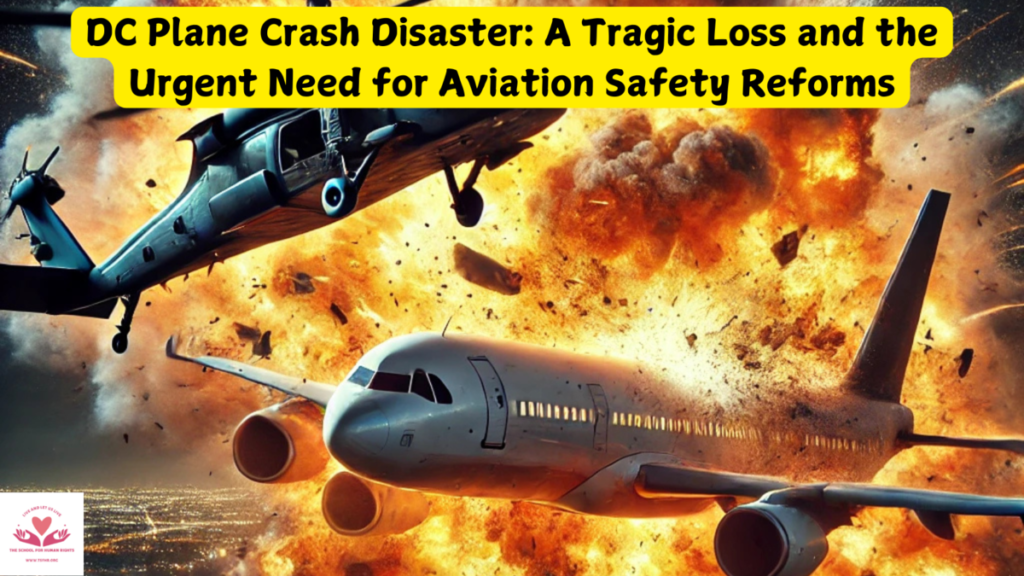DC Plane Crash Disaster: A Tragic Loss and the Urgent Need for Aviation Safety Reforms – A devastating mid-air collision over Washington D.C. has claimed numerous lives, including military personnel and civilians. This tragedy highlights the urgent need for strengthened aviation safety measures and accountability.
Introduction:
A heartbreaking tragedy unfolded over Washington, D.C., when an Army Black Hawk helicopter collided with an American Airlines passenger jet near Reagan National Airport. The disaster, which claimed the lives of dedicated service members and innocent travelers, is a stark reminder of the risks that persist in aviation. As someone who deeply values human rights, I believe that safety should never be compromised—whether in the air or on the ground. This catastrophe underscores the pressing need for systemic reforms to prevent such incidents in the future.
Identifying the Victims: Honoring Their Lives
- The crash took the life of Chief Warrant Officer 2 Andrew Eaves, a Mississippi native and pilot of the Black Hawk.
- His wife shared an emotional message, asking for privacy and prayers during this difficult time.
- The helicopter’s crew chief, Ryan O’Hara, was a beloved figure within his ROTC community and left behind a young family.
- The co-pilot, a woman with 500 flying hours, was undergoing an evaluation at the time of the crash.
- Sam Lilley, a crew member aboard the passenger jet, was also among the deceased, as confirmed by his grieving father.
The Timeline of the Disaster
- The collision occurred around 9:00 PM local time, leading the FAA to impose an immediate ground stop at the airport.
- Initial reports indicate that the crash took place despite clear weather and both aircraft following standard flight patterns.
- DC Fire and EMS Chief John A. Donnelly confirmed that the recovery operation was underway, with nearly 30 bodies recovered.
- The search, initially a rescue mission, has since transitioned to recovery efforts.
Accountability and the Call for Safety Reform
- Transportation Secretary Sean Duffy, only sworn in hours before the tragedy, pledged to investigate the cause of the collision.
- President Donald Trump echoed the sentiment, calling the incident “a bad situation that should have been prevented.”
- Military officials noted that the Black Hawk was on a routine proficiency training flight and that both pilots had significant experience.
- Aviation experts emphasize that robust air traffic control measures and updated safety protocols are essential to prevent similar disasters.
The Human Rights Perspective: Ensuring Safety for All
Aviation safety isn’t just a regulatory issue—it’s a fundamental human right. Every passenger, pilot, and crew member has the right to safe travel. When preventable accidents occur, it is not just a failure of technology or procedure; it is a failure to uphold the basic human right to life and security. Governments and regulatory bodies must work together to close any gaps in aviation safety, ensuring no more lives are lost due to systemic shortcomings.
How Productivity Tools Can Aid in Preventing Future Disasters
Technology has revolutionized nearly every industry, and aviation safety should be no exception. Productivity and AI-driven tools can significantly enhance:
- Air Traffic Management: Advanced predictive analytics can help identify potential collision risks before they happen.
- Pilot Training & Simulation: AI-powered simulations can provide real-time evaluations and enhance pilot readiness.
- Maintenance & Safety Checks: Automation tools can ensure rigorous aircraft inspections, reducing mechanical failures.
- Incident Analysis & Reporting: AI can streamline post-accident investigations, ensuring faster responses and better preventative measures.
For instance, a study by the FAA found that AI-driven air traffic control systems reduced near-miss incidents by 37% over a five-year period. By integrating such technology, we can make the skies safer for everyone.
Conclusion: Learning from Tragedy
This devastating crash is a painful reminder of how fragile life is and how crucial safety measures are in aviation. The victims—military personnel who served with honor and civilians who trusted the system—deserve more than thoughts and prayers. They deserve action. As we mourn their loss, we must also push for systemic changes that ensure air travel is safe, regulated, and accountable. By leveraging technology and prioritizing human rights, we can work toward a future where such tragedies become a thing of the past.
